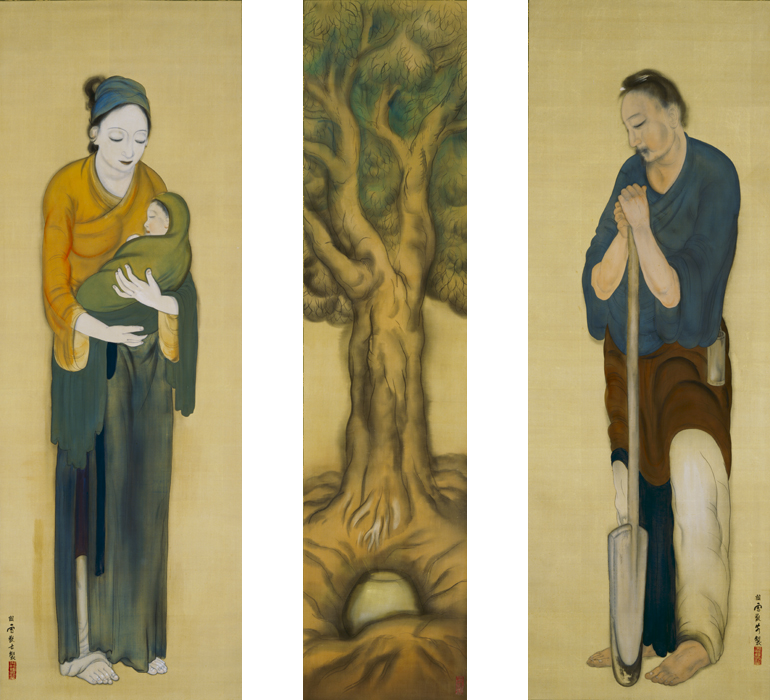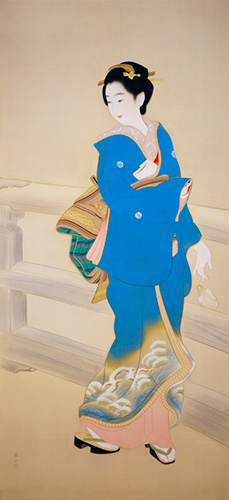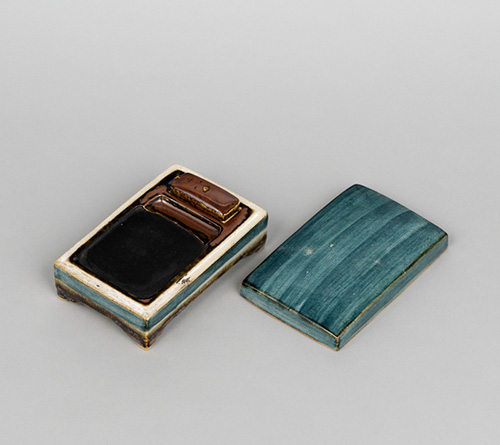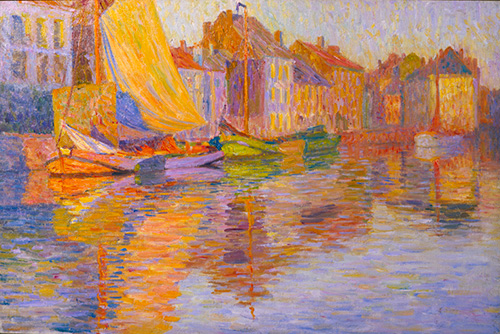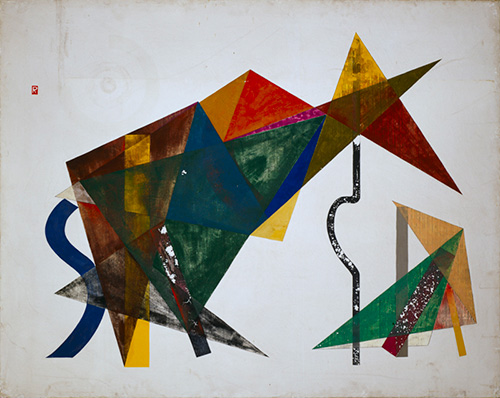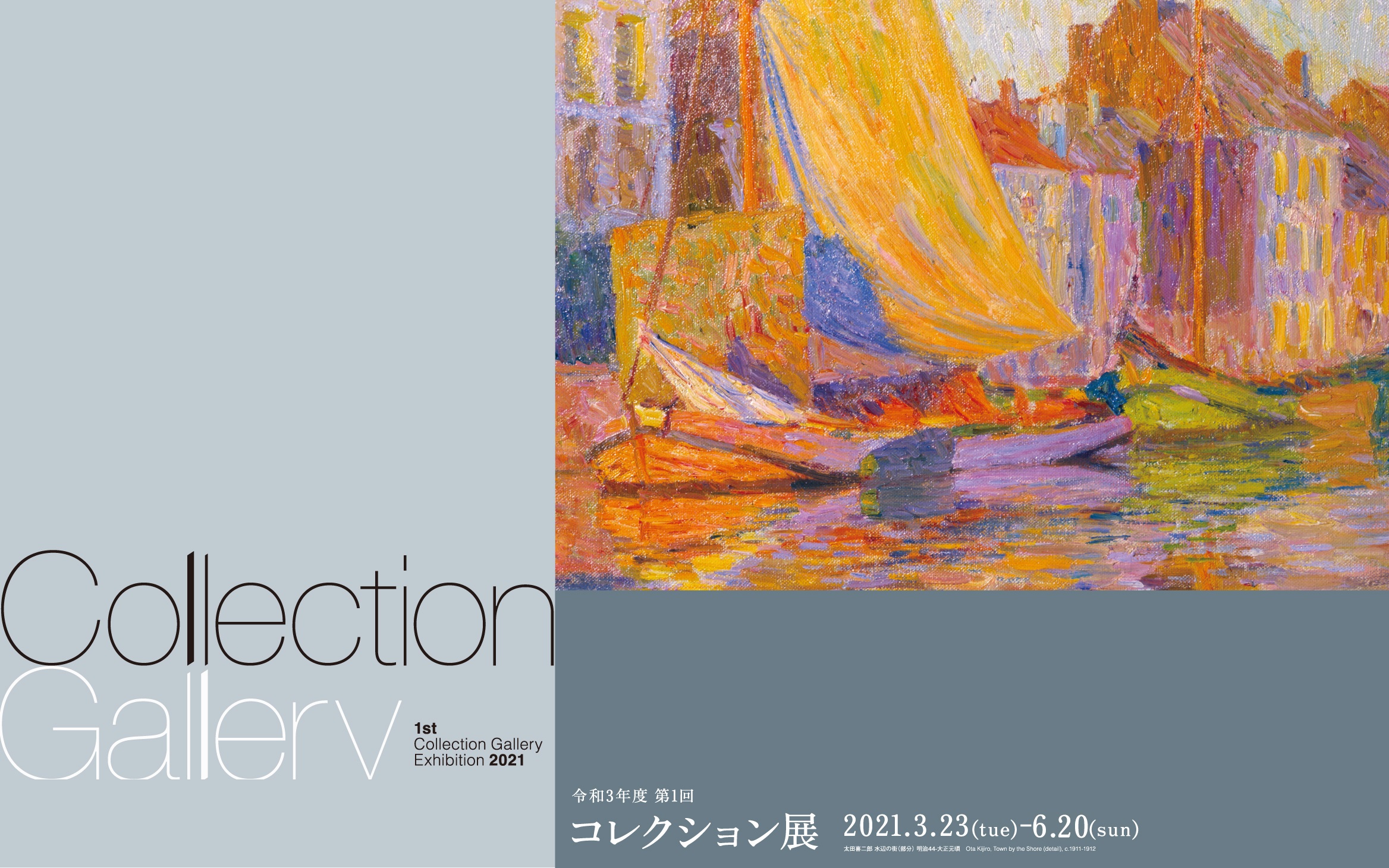
Collection Gallery
[Exhibition period has been extended! ]
1st Collection Gallery Exhibition 2021–2022
2021.03.23 tue. - 06.20 sun.
Selected Works of Western Modern Art
In this section, we introduce outstanding works of Western modern art, which are contained or deposited in the museum collection. The theme of the exhibit is “busts.” The term “bust” refers to sculptures or paintings that depict the upper part of the human body, including the head and chest. For example, during the New Kingdom of Egypt, it was common to make sculptural busts of the deceased. And, as is evident from displays in the Louvre and other museums, numerous busts were created in the Roman era to commemorate emperors and other government officials. Although the form declined during the Middle Ages, there was a resurgence of busts (especially in painting) in the Renaissance. This genre was later formalized as the most classic and academic human depiction in Western art. The models for these legendary busts were important historical or social figures of the day. In these works, priority was placed on the accurate portrayal of the person’s social characteristics, rather than a precise depiction of their external features. But, in the 19th century, due to the increasing interests upon the human being itself, bust models came to include ordinary people, and as a result, life-like depictions were also prized. Examples of this straightforward approach include the paintings of the Neoclassical master Jean-Auguste Dominique Ingres, who is thought to have referred to photographs in making his work. The 20th century saw a strong interest not only in capturing the external characteristics of the model but also in depicting their inner being. However, the process of searching for an expressive technique led some artists to display their own individuality, which tended to take precedence over reproduction. This change is evident from our own experience of looking first at the artist’s name rather than the model in bust paintings by Van Gogh and Picasso.
With the exception of Aristide Maillol’s Bust of Venus, an imaginary poetic bust according to his own words, each painting in this section must have been made by referring to an actual model. Yet, although Modigliani’s work bears the name of his lover at the time, any painting does not include certain information that would enable us to identify the model. The things we can see in Renoir’s painting are the model’s rose hat, her bright vermilion clothes and shiny skin, and in contrast her gaze filled with ennui, that express her youth and vitality. Inspired by Cézanne and primitive sculpture, Modigliani arrived at his singular expression by referring to classical Italian art after making sculpture for a time. Moïse Kisling created a lucid contrast by evoking deep brilliant colors with the classical technique of applying multiple layers of thinly transparent paint. In other words, both works capture our eye with their experimental approach to composition and color. Only Kees Van Dongen’s work, also known as La Parisienne, conveys the fact that the model is a self-sufficient woman of high social standing (though we cannot identify her either) based on her powerful forward stare, and her luxurious clothing and ornaments.
Human Expressions in Japanese-style painting HASHIMOTO Kansetsu, Guojo (Kakukyo) from “The Twenty-four Exemplars of Filial Devotion”, 1919
[on View: Mar. 23–May. 9] MIKI Suizan, The Flower of Meiji Restoration (Ikumatsu), 1940
[on View: May. 11–Jun. 13]
We use the single word “portraits” to describe all pictures of people, but its scope is extremely broad. People appear in Buddhist paintings of figures from religious texts, portraits of specific individuals, and paintings with narrative or allegorical content. When ukiyo-e prints appeared in the Edo Period (1603-1868), the genre of bijinga (“pictures of beautiful women”), such as geiko and maiko (geiko in training) became popular, and remained so even from the subsequent Meiji Era (1868-1912) onward. Artists also turned their attention to the lives of ordinary people, and created many works with familiar human subjects such as workers and mothers with children.
There is also great diversity of materials, techniques, and styles, ranging from paintings executed only in ink wash to those in the style of yamato-e (classical Japanese painting), those in the style of the Rinpa school, and those influenced by Western painting. In Kyoto in particular, after Maruyama Okyo rose to prominence in the Edo Period, human figures rendered with a solid grasp of anatomy became prevalent. Sugita Genpaku and others published Kaitai Shinsho (New Text on Anatomy), a Japanese translation of a European medical text, and as dissections were performed in the context of rangaku (lit. “Dutch studies,” referring in this case to Western medicine), understanding of the human body from a scientific perspective was attained. In this context, Okyo depicted people in a manner that looked convincingly realistic. In the modern era, painters sought to express their personal vision while referencing the realist tradition derived from Okyo and movements in Europe and the United States. Takehisa Yumeji’s trademark “Yumeji beauties,” the epitome of Taisho Era (1912-1926) romanticism, and Hoshino Shingo’s rubbed-copy method using actual vestiges of the human body are prime examples of artists forging original styles. Using distinctive Nihonga (modern Japanese-style painting) materials and textures, artists continuously honed their skills day to produce images of the human figure with a flavor unique to Nihonga.
Artist and Body MORIMURA Yasumasa, To My Little Sister/For Cindy Sherman, 1998
The early video works of Pipilotti Rist, currently the subject of a special exhibition at the museum, convey her utter devotion to tackling the creative challenge at hand. Similarly, many of the artists in this exhibit threw themselves into their work as a means of expression.
Fluxus was an avant-garde art community led by Lithuanian-born George Maciunas. In the 1960s, the artists, involved in a wide range of interdisciplinary activities, including art and music, in New York and Germany, organized a series of concerts and performances. Among the Japanese participants in the international network of artists were Yoko Ono, Kubota Shigeko, Ay-0, lchiyanagi Toshi, Shiomi Mieko, and Saito Takako. John Cage - a follower of Marcel Duchamp's who devised the concept of "chance operations" as a creative activity based on random events - played a leading role in Fluxus. Later in life, Cage developed a close relationship with Okura Jiro, a Japanese artist who had emigrated to the U.S., and Cage's ideas came to be introduced in Japan in workshops and other events.
In the 1960s, Kusama Yayoi staged performances in which she painted polka dots all over the bodies of completely nude models. She also made pictures filled with net patterns, and three-dimensional works known as "soft sculptures." In Traveling Life, a notable example of the latter, Kusama covered a stepladder with phallic protrusions to create a symbol of her obsessions.
Tanaka Atsuko, a member of Gutai, an art group led by Yoshihara Jiro, gave a performance in which she wore Electric Dress, a work made of approximately 200 light tubes and bulbs in nine different colors. Tanaka devoted the rest of her life to making a series of paintings that were inspired by the dress. Tanaka's large works, depicting the process in which light energy is converted into color and form, are imbued with her creative gestures.
As in painting, there have been a number of artists who made use of their own appearance as a subject in the medium of photography. By skillfully disguising themselves with makeup and clothing, the contemporary artists Morimura Yasumasu, Sawada Tomoko, and Lisa Anne Auerbach have gone so far as to manipulate their own identity and gender.
Handicrafts of the World
Crafts have developed in diverse ways around the world and throughout history, and broadly defined, they encompass all manner of human activity that shapes our lifestyles. In addition to objects we usually associate with it, such as clothing, tableware, and other daily utensils, the concept of “craft” was originally applied at times to such areas as landscaping, agriculture, and mining. In other words, people viewed all human participation in modification of objects and intervention in natural processes comprehensively as craft. Naturally, this included various objects and actions related to spirituality, decoration, and the body, and took on an immense variety of manifestations depending on era, region, culture, and role to be fulfilled.
In the modern era, this sweeping concept of “craft” came to be narrowed down, and with the development of industry and the emergence of primarily visual “fine art,” it became necessary for craftspeople to interpret crafts, both objectively and subjectively, in terms of the mass-produced versus the handmade, art versus craft and so forth. And as a result of systemic and cultural differences among countries and regions, and encounters with the foreign and unfamiliar, various arts and crafts movements have emerged worldwide and artisans have exercised their creativity within these frameworks.
The works shown in this area are by creators from the West. Since its opening in 1963, the museum has consciously endeavored to showcase trends in overseas arts and crafts from time to time. At the beginning of this text, crafts were described as “human activity that shapes our lifestyles.” These works emerged from reinterpretation of materials, techniques, and the act of fabricating objects through the lens of individual artists’ sensibilities, rooted in the culture and civilization of their day, and can be said to symbolically embody the myriad lives led in these places and times.
Selected Works of KAWAI Kanjiro from the Kawakatsu Collection KAWAI Kanjiro, Cobalt Blue Lidded Ceramic Inkstone, c. 1936
The Kawakatsu Collection, which includes a grand-prize winning piece from the 1937 Paris International Exposition, constitutes the most substantial public collection of Kawai Kanjiro’s works in terms of both quality and quantity.
The collection was donated to the museum by the businessman Kawakatsu Kenichi in 1968. When a museum curator went to see Kawakatsu’s huge collection of Kawai’s works, which placed an entire space of his house, he said, “Choose as many as you like.” In the end, 415 items were selected. Along with three pieces that Kawakatsu had previously donated to the museum and seven others that were subsequently added to address a lack of Kawai’s early works, the collection eventually totaled 425 works. Made up of important works by the artist, stretching from his first efforts, which were modeled on Chinese porcelain, to his final pieces, made after his involvement with the Mingei movement, the collection is truly a chronological encyclopedia of Kawai’s ceramics that spans his entire career.
Kawakatsu (1892-1979), who assembled the collection, worked as the advertising manager at the Tokyo branch of Takashimaya Department Store as well as serving as the store’s general manager, and the senior managing director of the Yokohama branch. In his role as a member of the Ministry of Commerce and Industry’s craft examination committee, he also strove to foster craft designs.
Kawai’s long friendship with Kawakatsu began when he went to meet the artist at the station when Kawai traveled to Tokyo for a meeting regarding the 1st Creative Ceramics Exhibition, which was held at Takashimaya in 1921. Immediately sensing that they were kindred spirits, Kawakatsu began collecting Kawai’s works. Reminiscing about the collection, Kawakatsu said, “It wasn’t merely based on my personal taste. Sometimes Kawai would make works for the collection and he also chose lots of pieces for it.” He added, “It was the crystallization of our friendship.”
Japanese Pleinairism with a Focus on OTA Kijiro and OKUBO Sakujiro OTA Kijiro, Town by the Shore, c. 1911-12
This year marks 70 years since the death of Kyoto-born painter Ota Kijiro (1883-1951), and last year marked 130 years since the birth of Osaka-born painter Okubo Sakujiro (1890-1973). Though these two artists did not have particularly close ties, they had in common that they were students of Kuroda Seiki, and that they practiced plein-air painting in Japan.
Plein-air painters work outdoors, often painting landscapes, and using vivid colors to render the effects of natural light. This approach is associated with the Impressionists, but other painters influenced by Impressionism are also described as plein-air painters. In Western art before the advent of plein-air painting, the common practice was to make sketches and studies outdoors and then refer to these while painting indoors in the studio, and painters did not seek to replicate the brightness of the naturally lit world as is. However, with the emergence of painters working outdoors in various parts of Europe in the 19th century, and especially with the rise of the Impressionists, approaches to expression of color were revolutionized.
This style was introduced to Japan by Kuroda Seiki, and he popularized it through Hakuba-kai (“White Horse Society”), the artists’ group he formed, and through his professorship at Tokyo Fine Arts School (precursor of today's Tokyo University of the Arts). It eventually came to be synonymous with academicism in the Western-style painting world in Japan, and painters emerged who were influenced by Post-Impressionism and sought to move beyond it, or who endeavored to incorporate elements of Japanese-style painting. Ota and Okubo can be characterized as painters who continued to pursue the mild, moderate expression of light effects, studying abroad in Europe and re-learning the pointillist techniques of Impressionism.
In this exhibit, we present works from the museum’s collection or deposited to the museum, by these two artists as well as plein-air painters of the same period.
The Rekitei Bijutsu Kyoukai: YAMAZAKI Takashi, YAMAOKA Ryobun, and Others YAMAOKA Ryobun, Spannung, 1938
After the Pan Real Art Association disbanded in April of last year, the museum immediately set about organizing a special exhibit last autumn, but as it happened, prior to that we were already planning a special exhibit entitled The Rekitei Bijutsu Kyokai (Rekitei Art Association) to Pan Real and the Pan Real Art Association. Now, the current exhibit has been reorganized so as to focus on the Pan Real Art Association's prehistory, with a focus on the Rekitei Art Association and especially its members Yamazaki Takashi and Yamaoka Ryobun.
In the first two decades of the Showa Era (1926-1989), many associations dedicated to the study and pursuit of art were established in Japan, and their members exhibited as a group. This was true in the world of Nihonga (modern-Japanese style painting) as elsewhere, and group after group was formed and disbanded by young painters who belonged to mainstream organizations, such as those operating the state-sponsored Kanten and Inten exhibitions and the Seiryusha Exhibition, but were dissatisfied with that environment. One such group was the Rekitei Art Association, formed in 1938. It was named by Takiguchi Shuzo, formed by Yamaoka Ryobun and Funada Gyokuju – members of the Western-style painting group Free Artists Association (Jiyu Bijutsu Kyokai) which included Hasegawa Saburo and Murai Masanari – and was initially influenced by European avant-garde movements such as abstraction, Surrealism and the Bauhaus, while in terms of technique its members boldly experimented with frottage, decalcomania, filing down of painting surfaces, and spraying of mineral pigments, none of which are found in traditional Nihonga. Also, photography was included in their first shisaku (trial piece) exhibition in 1939, and for their third exhibition (the second since becoming a public open-call exhibition) in 1940, the four categories accepted were “painting,” “collage,” “three-dimensional works,” and “photography.” Other categories were subsequently added – commercial art such as posters, interior decoration, ceramics, metalwork, textiles, and Adachi School flower arrangement – with the goal of advancing an “integrated art movement.” However, as World War II intensified the group was integrated with Bijutsu Shinkyo and Meiro Bijutsu Renmei to form Nihon Sakka Kyokai in 1943, the year after the 8th exhibition, and its activities ceased for the time being.
After Funada and others left Rekitei, from the second exhibition onward Yamaoka Ryobun in Tokyo became the de facto leader, and as he had attended the Kyoto Municipal Specialized School for Painting, nicknamed “Kaisen” (though he did not graduate), students who had been his juniors at the school joined the group. Among them was Yamazaki Takashi, who had been conscripted following the outbreak of the Second Sino-Japanese War and injured in the fighting. After returning to Japan he participated in the first shisaku (trial piece) exhibition, and became a central figure in the Kyoto chapter of the group. After his repatriation in 1946, Yamazaki invited Mikami Makoto, who had been his junior at Kaisen and whose talent he recognized, and sought to resurrect Rekitei with Tokyo-based Yamaoka Ryobun, but their efforts were frustrated. Instead, Yamazaki called on promising young Kaisen students Hoshino Shingo, Fudo Shigeya, Tanaka Susumu (Ryuji), and Sato Katsuhiko to form a new organization active only in Kyoto. They were joined by Yagi Kazuo (Kyohei), who had participated in Rekitei from 6th exhibition onward, his friend Suzuki Osamu, and Aoyama Masakichi, who was enrolled in the Nihonga department at Kaisen but worked in a Western style, and Pan Real was formed, holding its first exhibition in Kyoto in 1948. Two months later Yagi and Suzuki withdrew and formed the ceramicists’ group Sodei-sha, and with Aoyama uncertain about whether or not to remain, Pan Real was reformulated as the Nihonga group Pan Real Art Association. With the support of Fukuzawa Ichiro and Komaki Gentaro of the Art Culture Association (Bijutsu Bunka Kyokai), the new group’s first exhibition was staged in May 1949. The Pan Real Art Association, which inherited the genes of the Rekitei Art Association as a group of marginalized avant-garde Nihonga painters with ties to contemporaries working in Western styles, remained active after the withdrawal of Yamazaki in 1958, and finally disbanded in April last year, as mentioned at the beginning of this text. Later Impression of Battlefield (Part 5), exhibited at the 8th Rekitei exhibition, was re-exhibited with the title Landscape at the 1st Pan Real Art Association exhibition, an indication of how for Yamazaki, Rekitei and Pan Real formed one continuous narrative.
Exhibition Period
2021.03.23 tue. - 06.13 sun.
2021.03.23 tue. - 06.20 sun.
[First term]
3.23 tue.~5.9 sun.
[Second term]
5.11 tue.~6.13 sun.
5.11 tue.~6.20 sun.
Themes of Exhibition
Selected Works of Western Modern Art
Human Expressions in Japanese-style painting
Artist and Body
Handicrafts of the World
Selected Works of KAWAI Kanjiro from the Kawakatsu Collection
Japanese Pleinairism with a Focus on OTA Kijiro and OKUBO Sakujiro
The Rekitei Bijutsu Kyoukai: YAMAZAKI Takashi, YAMAOKA Ryobun, and Others
[Outside] Outdoor Sculptures
List of Works
1st Collection Gallery Exhibition 2021–2022 (168 works in all) (PDF)
Free Audio Guide App
How to use Free Audio Guide (PDF)
Hours
9:30AM–5:00PM
*Fridays and Saturdays: 9:30AM–8:00PM
*Admission until 30 min. before closing
*Opening hours is subject to change, due to the prevention against COVID-19 pandemic. Please check the updated information, before your visit.
Admission
Adult: 430 yen (220 yen)
University students: 130 yen (70 yen)
High school students or younger,seniors (65 and over): Free
*Figures in parentheses are for groups of 20 or more.
Collection Gallery Free Admission Days
March 27 and April 3, 2021
Night Discount for Collection Gallery
Adult: 220 yen
University student: 70 yen
*The Discounted admission is only available after 5 P.M. on Fridays and Saturdays
*Admission until 30 minutes before closing.
Free Audio Guide App How to use Free Audio Guide (PDF)



